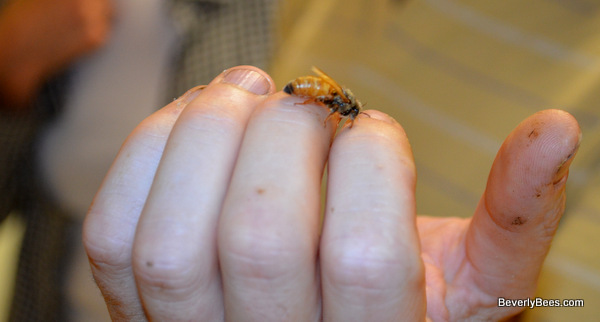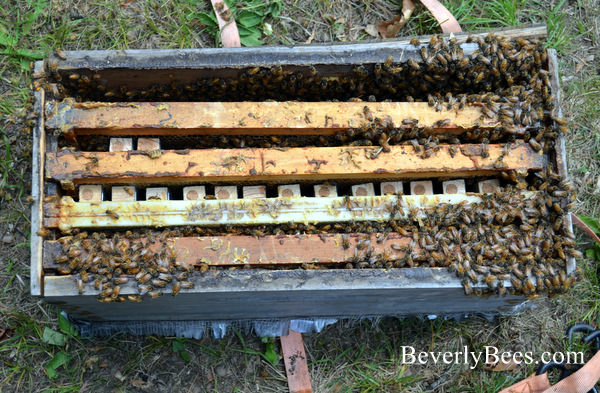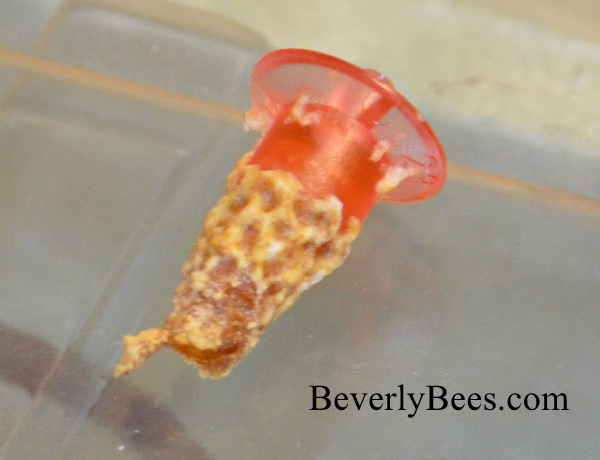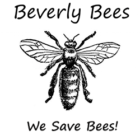Queen Rearing With Dean Stiglitz
Dean Stiglitz from Golden Rule Honey gave a few talks at the treatment free conference about queen rearing. Dean is the coauthor of The Complete Idiot’s Guide to Beekeeping. During field day Dean let everyone try their hand at grafting a queen using the Chinese grafting tool. This was a lot fun! Dean raises virgin queens for sale. Virgins are mated locally and will impart local genetics to your hive. When you buy a mated queen you are wholesale replacing the genetics of the hive and it is probably with nonlocally adapted stock. Not many people are raising virgins for sale and Dean has discovered a few tricks to do it right. Bees don’t pay attention to virgins and won’t take care of them or release them from a cage they way they do a mated queen. In order to get caged virgins fed you need to place them in between frames of open brood. Then the nurse bees will take care of them while they are tending to the larvae.

You can get the bees to build queens a few different ways. You can build up a single box swarm by putting two boxes into one by shaking all the bees down. The bees will get crowded and want to swarm. You can also cut the bottom of a brood frame with eggs on it and the bees will draw queen cells on the bottom of the frame. It is probably the easiest to crowd the colonies of bees with the genetics you want to propagate.
Dean grafts the queens using a grafting frame he made. After the queen cell is capped there is a sensitive period up until three days before the queen emerges. You can use a serrated knife to cut out queen cells and move them any time while the cell is uncapped or after the sensitive period. When the cells are capped and the queens are about to hatch and at a safe stage for moving (queens in the cell are very delicate and there is a short window between when they can be safely transported and when they hatch) Dean puts them into a reptile incubator kept at 94 degrees. Most people keep the queens at 93 degrees but Dean uses 94 degrees because the incubator is very accurate. He takes the cell off the grafting bar and puts the capped end into a California queen cage and the queen hatches directly into the cage. Occasionally the virgins will also pipe in there which I got to hear for the first time – very fun! After they hatch, Dean inspects them for defects by letting them walk on his hand. The most common defect is to the front legs and can be observed by the way the queen walks. If the queen has deformed wings or a gimpy walk she will not be used. Dean will place the queens into a nuc for a week so the bees can take care of them and feed them until the virgins are ready to fly. While they are in the incubator Dean feeds them honey by putting a few drops on the cage screen.

When virgins are released into the hive, the bees don’t pay much attention to them. As Dean says “They are virgin queens and are supposed to be stealthy.” The virgins feed themselves. Here is a short video where Dean demonstrated that the bees do not pay much attention to caged virgin queens by introducing one into a hive.
In order to release the virgin you need to smoke the bottom of the hive until the smoke comes out the top. Then release the virgins on the tops bars and close the hive up. Releasing virgins works best during a flow. By the time the smoke dissipates the bees will accept the virgin because she will smell like the hive.

To make a cell builder Dean uses a five frame nuc with a screened bottom stacked two high. The bottom nuc has empty foundationless frames. The top nuc has honey on the outside, two frames of capped brood, followed by open brood and pollen. The middle position is for the frame with queen cells. Nucs with new queens can be made in our area from swarm season until the middle of August for overwintering.
“Queen rearing is too important to leave to someone else.”- James Powers
Queen rearing allows the beekeeper to build on genetics. Nutrition is paramount to the bee, followed by mating, then genetics. Growing your own pays off with queen rearing. You can raise high quality queens with minimum expense and work. The beekeeping industry needs more queen breeders than there is room for commercially. Once you learn how to do it you won’t be able to help yourself. We need people breeding bees not just raising queens.
You can expect to raise more queens than you can use. A well mated queen with good genetics will perform well. You can maintain your stock and develop your own local strain. Queens are raised by the beekeeper as part of a system. The system must be nourished and well provisioned. Then only after a queen shaped hole is produced in the colony will the bees produce a queen. In order to raise a queen you need at least one strong colony, if you want to raise more queens you need more resources to draw from.
Make up the cell builder a day or two before grafting. The bees should be ready for new queen cells. Place the grafted cups in the hive as soon as possible after grafting, preferably immediately. Check the cells after a day or two and then move them to the cell finisher colony. Leave them there for 9-10 days after grafting before moving them to an incubator or somewhere else. If you are wondering about the math, this is how it breaks down. It takes 3 days for an egg to hatch and the queen is a larvae for approximately 5.5 days before capping. The cell will be capped for about 7.5 days for a total development time of 16 days from egg to hatching (as opposed to 21 days for a worker and 24 days for a drone). The larvae you grafted should be a day or two old, which means it is at day 4-5 in the development time. So 9-10 days after grafting gets you to day 13-14. At this stage the cell is beyond the sensitive period and can be moved safely.
Methods for Queen Rearing
Walk Away Split – This method takes a long time but is simple. You take a 2 deep hive and divide it in half. You just split it and walk away. However you will not get new bees for 1.5 months but it does put a break in the brood cycle and may stall swarming. You should be sure both deeps have honey, pollen, open and capped brood. The hive without the queen will go 6 weeks before it has emerging brood. You can add capped brood 3 weeks after splitting to give the hive a boost in nurse bees.
Natural Queen Cells – During a hive inspection you find a queen cell and decide it’s time to make a split or put these cells in a nucleus colony. This saves you time as these cells are usually produced out of abundance. This method requires no planning and can be used as swarm prevention. It is an easy way to increase your number of hives. If the cells are uncapped you can move them. If they are capped they are very fragile until 3 days before hatching. It is very easy for a queen in a capped cell to fall off the royal jelly and die. Since you may have no idea when these cells were capped, you don’t know how old or fragile the cell is. Bees are also very good at hiding cells. You should use a brush to remove bees to look for all the queen cells if you decide to harvest these cells.
Forcing Queen Cells – They can be produced out of abundance for the convenience of the beekeeper and timed for perfect handling of the capped queen cells. If you don’t want to graft you can shake all the bees from two or more boxes into one box and they will get crowded and produce swarm cells. You also need to move the brood, eggs and stores into that one box. Two more methods to use and read about are the Hopkins Method and the Miller Method. Michael Bush has published a great book on queen rearing called the Classic Queen Rearing Compendium.

If you want to raise queens read as many books as you can on the subject. Bees want queens and will make them from a larvae of the proper age when they have enough resources and suitable cells. They need nurse bees which you will find on the open brood. The best time to raise queens is on a flow. Everything with bees just works better on a flow.
Drone colonies need to be employed and drones need to be produced to get a well mated queen. It helps to keep drone right colonies to saturate the drone congregation areas with the genetics you want.
Breeding queens is different from raising queens. Even if you are grafting queens that is not a breeding program. Mixing and matching genetics is not far enough for a breeding program. You need uniformity of stock. Start with what you have, maybe bring in a few different lines to cross all at once. Don’t fall for the bees are always greener on the other side trap. You will provide excellent queens with any genetics if they are well nourished and well-bred. Mixing and matching genetics offers nothing predictable. You want uniform stock with desirable consistent traits for crossing. Push your breeding program in the direction of natural selection. Inbreeding fixes traits, out breeding creates “vigor.” Inbreeding is easy to avoid in honeybees. Consider introducing new stock as drones. No matter how tightly you control things the bees will defy you.
Assist others with queens. Virgins are easy to produce and cheap. Share your stock with your neighbors. Those queens will make up the drone colonies that will mate with your queens. Give your neighbors queens for free and only take desirable stock into your own operation. Mating nucs take up a lot of resources and proper mating takes time, requires more handling and precautions. However on a small scale you can raise first rate queens for yourselves and your neighbors.
Here are a few more pictures from the conference. Click on a picture to open the gallery and click on the arrows to scroll through the photos. If you click on the picture the gallery will close. If you are reading this in an email or a reader and the gallery does not display properly, please click on the post to view the gallery on the website. Enjoy!!












